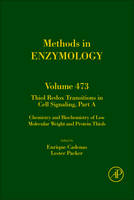
Thiol Redox Transitions in Cell Signaling, Part A
Academic Press Inc (Verlag)
978-0-12-381345-9 (ISBN)
Thiol Redox Transitions in Cell Signaling, Part A, along with its companion (volume 475), presents methods and protocols dealing with thiol oxidation-reduction reactions and their implications as they relate to cell signaling. This first installment of Cadenas and Packer's two-volume treatment specifically deals with glutathionylation and dethiolation, and peroxide removal by peroxiredoxins/thioredoxins and glutathione peroxidases.
The critically acclaimed laboratory standard for 40 years, Methods in Enzymology is one of the most highly respected publications in the field of biochemistry. Since 1955, each volume has been eagerly awaited, frequently consulted, and praised by researchers and reviewers alike. Over 450 volumes have been published to date, and much of the material is relevant even today--truly an essential publication for researchers in all fields of life sciences.
ENRIQUE CADENAS, MD, PhD, received his PhD in biochemistry from the University of Buenos Aires, School of Medicine. He is professor of pharmacology and pharmaceutical sciences at the University of Southern California School of Pharmacy and of biochemistry and molecular biology at the University of Southern California Keck School of Medicine, and doctor honoris causa (medicine) at the University of Linköping, Sweden. Cadenas was president of the Society for Free Radical Research International (SFRRI) and is fellow of the Society for Free Radical Biology & Medicine. He served the scientific community by participating on NIH study sections (2002-2006; chair 2006-2008). His research interests include energy and redox metabolism in brain aging and the coordinated inflammatory-metabolic responses in brain and neurodegenerative diseases. Lester Packer received a PhD in Microbiology and Biochemistry in 1956 from Yale University. In 1961, he joined the University of California at Berkeley serving as Professor of Cell and Molecular Biology until 2000, and then was appointed Adjunct Professor, Pharmacology and Pharmaceutical Sciences, School of Pharmacy at the University of Southern California. Dr Packer received numerous distinctions including three honorary doctoral degrees, several distinguished Professor appointments. He was awarded Chevalier de l’Ordre National du Merite (Knight of the French National Order of Merit) and later promoted to the rank of Officier. He served as President of the Society for Free Radical Research International (SFRRI), founder and Honorary President of the Oxygen Club of California. He has edited numerous books and published research; some of the most cited articles have become classics in the field of free radical biology: Dr Packer is a member of many professional societies and editorial boards. His research elucidated - the Antioxidant Network concept. Exogenous lipoic acid was discovered to be one of the most potent natural antioxidants and placed as the ultimate reductant or in the pecking order of the “Antioxidant Network regenerating vitamins C and E and stimulating glutathione synthesis, thereby improving the overall cellular antioxidant defense. The Antioxidant Network is a concept addressing the cell’s redox status. He established a world-wide network of research programs by supporting and co-organizing conferences on free radical research and redox biology in Asia, Europe, and America.
His-tag switch method for the analysis of S-nitrosylated proteins
Identification of Protein Thiols in Mitochondrial Oxidative Phosphorylation Complexes
Mitochondrial thioredoxin reductase: purification, inhibitor studies, and role in cell signaling
assessing cell surface thiol status
Induction of Thioredoxin for Mediating Preconditioning-induced Cellular Responses
A trans sarcoplasmic reticulum membrane redox sensor in the striated muscle: exploring redox sensitivity of the ryanodine receptor calcium release channel
Rapid approach for the detection, quantification and discovery of novel sulphenic acid or S-nitrosothiol modified proteins using a biotin-switch method
Direct identification by mass spectrometry of in vivo S-nitrosylated peptides
Changing paradigms in theology: From antioxidant defence to redox regulation
Determination of GSNO formation in biological samples by HPLC electrochemical detection
Alteration of thioredoxin reductase 1 levels in elucidating cancer etiology
thiol-labeling technology in proteomics
Analytical methods for the determination of sulfur metabolite concentrations in cell extracts
Chemical tagging and mass spectrometry-based identification of protein thiols modified by lipid peroxidation-derived a,b-unsaturated aldehydes
Measuring protein thiol redox changes in mitochondria
Engineering of redox domains for monitoring electron transfers spectroscopically
Approaches to detection of cysteine sulfenic acids in proteins using dimedone-based chemical probes
Evaluation of conditions affecting degree of sulfenic acid labeling in redox-sensitive proteins
Colorimetric and spectrophotometric assays of sulfiredoxin
Quantifying disulfides in specific proteins
A simple method of detecting oxidatively-modified proteins
Role of Glutathione Conjugates in Cell Signaling
Regulation of Protein Function by Sulfinic Acid Formation
Mass spectrometry approaches for the study of the oxidation state of protein cysteine residues
assays of protein tyrosine phosphatase oxidation
oxidation state of cellular 2-Cys peroxiredoxins (reduced thiol, disulfide and hyperoxidised) by non-reducing SDS-PAGE and immunoblotting
| Erscheint lt. Verlag | 22.7.2010 |
|---|---|
| Reihe/Serie | Methods in Enzymology |
| Verlagsort | San Diego |
| Sprache | englisch |
| Maße | 152 x 229 mm |
| Gewicht | 810 g |
| Themenwelt | Studium ► 1. Studienabschnitt (Vorklinik) ► Physiologie |
| ISBN-10 | 0-12-381345-X / 012381345X |
| ISBN-13 | 978-0-12-381345-9 / 9780123813459 |
| Zustand | Neuware |
| Haben Sie eine Frage zum Produkt? |
aus dem Bereich


